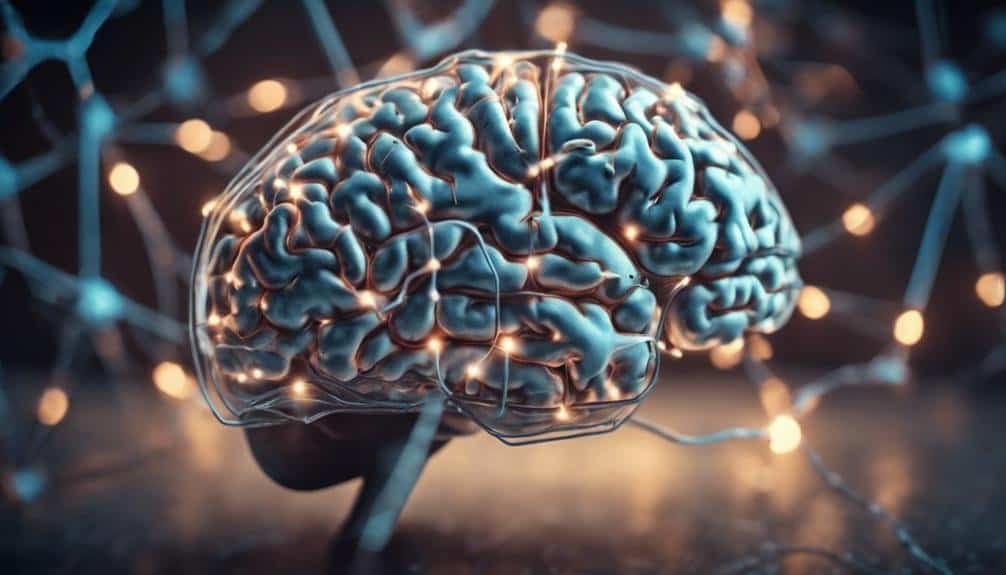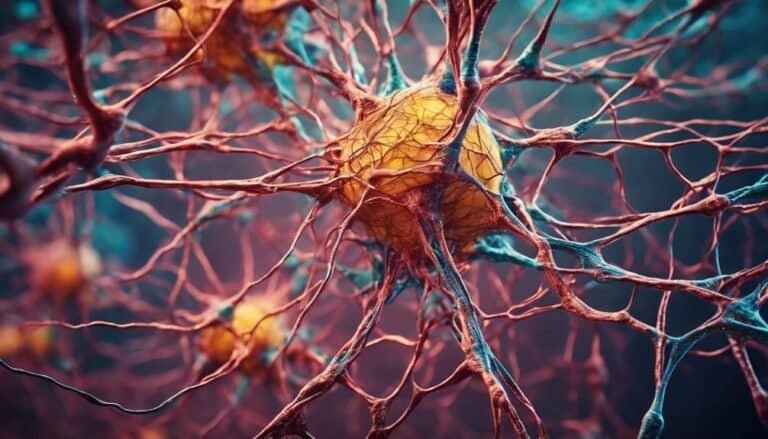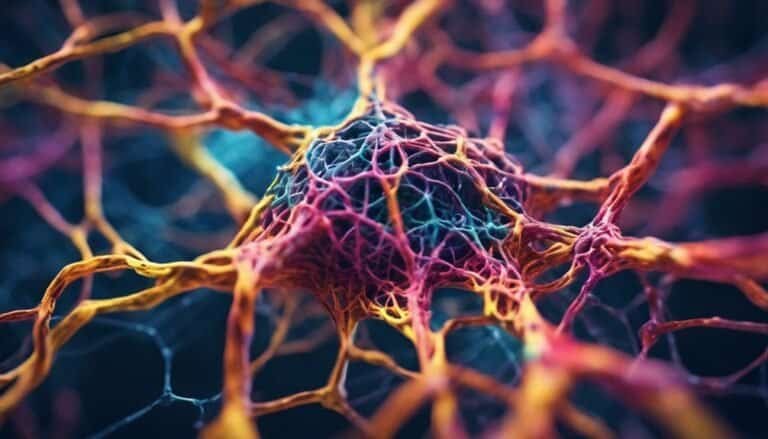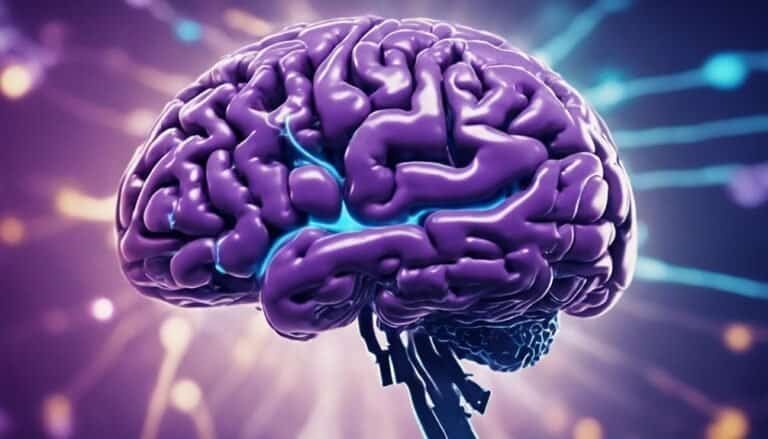Brain's Role in Goal Setting and Achievement
Did you know that the brain plays a crucial role in not only setting goals but also in achieving them?
From the intricate dance of neurotransmitters like dopamine to the strategic planning orchestrated by the prefrontal cortex, your brain is a powerful ally in your quest for success.
But how exactly does your amygdala influence your emotional responses and impact your goal pursuits?
Understanding the complex interplay of brain regions and functions can provide valuable insights into optimizing your goal-setting strategies for maximum effectiveness.
Key Takeaways
- Neural networks coordinate brain regions for goal pursuit.
- Dopamine levels influence motivation and persistence.
- Prefrontal cortex guides decision-making and planning.
- Cognitive control mechanisms aid in goal achievement.
Neurological Basis of Goal Setting
Understanding the neurological basis of goal setting provides crucial insights into the mechanisms that drive human motivation and achievement. Neural networks play a fundamental role in this process by facilitating communication between different regions of the brain. When you set a goal, various neural networks are activated, such as the prefrontal cortex responsible for decision-making and the limbic system involved in emotion regulation. These networks work together to coordinate cognitive processing, including planning, organizing, and monitoring progress towards the goal.
Cognitive processing is essential for effective goal setting as it involves higher-order thinking skills like problem-solving and reasoning. By engaging in cognitive processes, you can break down complex goals into smaller, manageable tasks, enhancing the likelihood of successful goal attainment. Additionally, cognitive flexibility allows you to adapt your strategies in response to feedback and changing circumstances, improving your chances of achieving desired outcomes.
Impact of Dopamine on Motivation
The impact of dopamine on motivation is a well-documented phenomenon in neuroscience research, shedding light on the crucial role this neurotransmitter plays in driving goal-directed behavior. Dopamine regulation within the brain is intricately linked to motivation, with studies showing that fluctuations in dopamine levels can significantly impact an individual's drive to achieve goals. When dopamine levels are high, there's a notable motivation boost, leading to increased persistence, focus, and reward-seeking behavior. On the contrary, low levels of dopamine have been associated with reduced motivation, potentially hindering goal-directed actions.
Research has revealed that dopamine not only influences the initiation of goal-directed behavior but also plays a key role in sustaining motivation over time. By modulating neural pathways involved in reward processing and reinforcement learning, dopamine acts as a signal for the brain, indicating the value of pursuing a particular goal. Understanding the intricate interplay between dopamine regulation and motivation is crucial for comprehending how the brain drives individuals towards goal achievement.
Role of Prefrontal Cortex in Planning
The prefrontal cortex plays a crucial role in planning and decision-making, with its executive functions heavily involved in these processes.
Research indicates that damage to the prefrontal cortex can lead to impairments in planning abilities and goal-directed behavior.
Understanding the intricate workings of the prefrontal cortex is essential for comprehending how the brain navigates the complexities of setting and achieving goals.
Planning in Prefrontal Cortex
Within the intricate network of the brain, the prefrontal cortex plays a crucial role in the planning process, orchestrating the sequential steps necessary for goal-directed behavior. Research indicates that this brain region is pivotal for decision making, problem solving, cognitive flexibility, and adaptability.
Studies using neuroimaging techniques have shown increased prefrontal cortex activity during tasks requiring planning, suggesting its involvement in organizing and structuring actions towards a specific objective. Furthermore, damage to the prefrontal cortex can lead to difficulties in planning and executing tasks efficiently.
Executive Function Involvement
In exploring the role of the prefrontal cortex in planning, it becomes evident that executive functions are intricately involved in orchestrating goal-directed behavior and cognitive processes. The prefrontal cortex, known for its role in decision-making, plays a crucial part in managing executive functions such as working memory, cognitive flexibility, and inhibitory control.
Key Points:
1) Working Memory: The prefrontal cortex aids in holding and manipulating information to guide decision-making processes.
2) Cognitive Flexibility: This brain region supports the ability to adapt to changing circumstances and switch between different tasks efficiently.
3) Inhibitory Control: The prefrontal cortex helps in suppressing impulsive actions and maintaining focus on long-term goals, essential for successful decision-making strategies.
Influence of Amygdala on Emotions
During emotional experiences, the amygdala plays a crucial role in processing and regulating feelings. Research indicates that amygdala activation is closely linked to emotional regulation. When the amygdala is activated, it can trigger a range of responses in the body, including the release of stress hormones like cortisol and adrenaline. These responses can impact your emotional state and influence how you perceive and react to different situations. Studies have shown that individuals with heightened amygdala activation may have difficulty regulating their emotions, leading to increased levels of anxiety or emotional reactivity.
Moreover, the amygdala is involved in processing both negative and positive emotions. It helps the brain determine the emotional significance of various stimuli, allowing you to distinguish between potential threats and rewards. Understanding how the amygdala influences emotions can provide insights into how our brain responds to different situations and stimuli. By studying amygdala function, researchers aim to uncover new ways to improve emotional regulation and overall well-being.
Connection Between Brain and Focus
Your brain's focus mechanisms play a crucial role in directing your attention towards specific goals and tasks.
Neural pathways responsible for focus help filter out distractions and enhance cognitive control.
Understanding the brain's cognitive control in focus can lead to improved goal setting and achievement strategies.
Brain's Focus Mechanisms
Utilizing neural networks, the brain orchestrates intricate mechanisms that direct and sustain focus towards specific goals and tasks. When it comes to focusing, your brain employs sophisticated processes to help you stay on track and achieve your objectives.
Here are three key aspects of the brain's focus mechanisms:
- Selective Attention: The brain's ability to focus on relevant information while filtering out distractions is crucial for goal-directed behavior.
- Sustained Attention: This mechanism allows the brain to maintain focus over an extended period, ensuring continued engagement with tasks despite potential distractions.
- Cognitive Control: By regulating attention and inhibiting impulses, the brain manages cognitive load effectively, optimizing performance on tasks requiring sustained focus and goal-directed behavior.
Neural Pathways and Attention
The connection between neural pathways and attention plays a crucial role in how your brain directs focus towards specific goals and tasks. Neural connections form intricate networks that help regulate attention.
Research shows that attentional networks involve various regions of the brain, such as the prefrontal cortex, parietal cortex, and thalamus. These networks facilitate the coordination of different cognitive processes involved in attention, including selecting relevant information and filtering out distractions.
Studies indicate that disruptions in neural pathways can impact attentional control, leading to difficulties in maintaining focus on tasks. Understanding the relationship between neural connections and attentional networks can provide insights into enhancing focus and improving goal-directed behaviors.
Cognitive Control in Focus
Examining cognitive control mechanisms reveals the intricate connection between brain function and the ability to maintain focus on specific tasks. When it comes to cognitive control in focus, several key aspects play a crucial role:
- Attentional Control: This involves the ability to concentrate on relevant information while filtering out distractions, ensuring that your focus remains on the task at hand.
- Cognitive Flexibility: The brain's capacity to adapt and switch between different tasks or thought processes seamlessly, enhancing problem-solving skills and overall cognitive efficiency.
- Working Memory and Inhibitory Control: Working memory allows for the temporary storage and manipulation of information, while inhibitory control helps in suppressing irrelevant or impulsive responses, both contributing significantly to sustained focus and goal-directed behavior.
Neuroplasticity and Goal Achievement
Understanding how neuroplasticity impacts goal achievement is crucial for optimizing success in various areas of life. Neuroplasticity refers to the brain's ability to reorganize itself by forming new neural connections throughout life. When it comes to goal achievement, neuroplasticity plays a significant role in shaping our behaviors, thoughts, and emotions towards reaching our objectives.
Research indicates that neuroplasticity benefits goal achievement by enabling individuals to adapt to new challenges, learn from failures, and enhance their skills continuously. By engaging in activities that promote neuroplasticity, such as learning new skills, seeking novel experiences, and practicing mindfulness, you can enhance your brain's capacity to support goal-directed behavior.
Incorporating neuroplasticity into your goal setting strategies involves setting realistic yet challenging goals, breaking them down into smaller achievable tasks, and consistently exposing yourself to new stimuli that encourage brain plasticity. By leveraging the brain's ability to reorganize itself, you can enhance your chances of successfully achieving your goals across various domains of life.
The Power of Visualization Techniques
Utilizing visualization techniques has been shown to significantly enhance goal attainment and performance outcomes in various fields. Mental imagery plays a crucial role in this process, as it allows individuals to create a vivid representation of their desired outcomes in the mind. By harnessing the power of visualization, you can tap into your mind's ability to influence your actions and decisions towards achieving your goals.
Key Points:
- Enhanced Focus: Visualization helps in sharpening your focus on the specific goals you want to achieve. The more detailed and immersive your mental imagery is, the better you can direct your attention and efforts towards realizing your objectives.
- Increased Motivation: Engaging in visualization exercises activates the mind's power of manifestation, reinforcing your belief in the attainability of your goals. This heightened sense of belief can fuel your motivation, keeping you dedicated and persistent in your pursuit of success.
- Improved Performance: Studies have shown that mental rehearsal through visualization can lead to improved performance outcomes. By mentally rehearsing successful scenarios, you're priming your brain to respond more effectively when faced with real-life challenges, ultimately enhancing your chances of success.
Brainwave States and Goal Attainment
To optimize goal attainment, it's crucial to explore the correlation between different brainwave states and their impact on cognitive performance and achievement. Brainwave frequencies play a significant role in determining your mental state and overall productivity. Research suggests that specific brainwave patterns are associated with heightened focus, creativity, and problem-solving abilities, all of which are essential for reaching your goals.
Mindfulness techniques, such as meditation practices, can help regulate brainwave frequencies by inducing states of deep relaxation and heightened awareness. By incorporating these practices into your daily routine, you can enhance your cognitive functions and improve your chances of success in goal pursuit.
Furthermore, maintaining a balanced neurotransmitter system is vital for optimal brain function and goal attainment. Meditation practices have been shown to promote neurotransmitter balance, particularly dopamine and serotonin levels, which are crucial for motivation, mood regulation, and overall cognitive performance. By harnessing the power of different brainwave states through mindfulness techniques and promoting neurotransmitter balance, you can effectively boost your goal achievement capabilities.
Conclusion
In conclusion, your brain is a complex and powerful tool that plays a crucial role in setting and achieving goals. Like a symphony conductor, it orchestrates the various neurological processes involved in motivation, planning, emotion regulation, focus, and neuroplasticity.
By understanding and harnessing the power of your brain, you can navigate the intricate pathways towards your desired achievements with precision and finesse. So, let your brain be the maestro of your success symphony, guiding you towards your goals with unwavering determination.







